originally posted at https://canmom.tumblr.com/post/701208...
Hi everyone! It’s Animation Night! Apologies for the late start today, I’ve not been in the best of sorts lately.
Tonight we’re going to be revisiting Makoto Shinkai. I’ve written about him before back on Animation Night 44, in which I related the start of his career and heavily praised the compositing in his films. At that time, I had seen little more than Your Name - but we took the chance to dive in and dig up his early works like She and Her Cat and Voices from a Distant Star.
Sadly, Weathering With You turned out to be a little disappointing - nothing egregiously off with it, there was indeed some lovely character animation, but the story was just a reiteration of the same familiar Shinkai sekaikei devices, so it just felt like a weaker take on Your Name. And I think this is the source of a lot of people’s frustration with Shinkai: the first film about a heterosexual couple torn apart by fate may seem novel, the fifth one it becomes kinda ‘oh there you go again, Makoto’. Or less charitably, you start calling them ‘tfw no gf movies’.
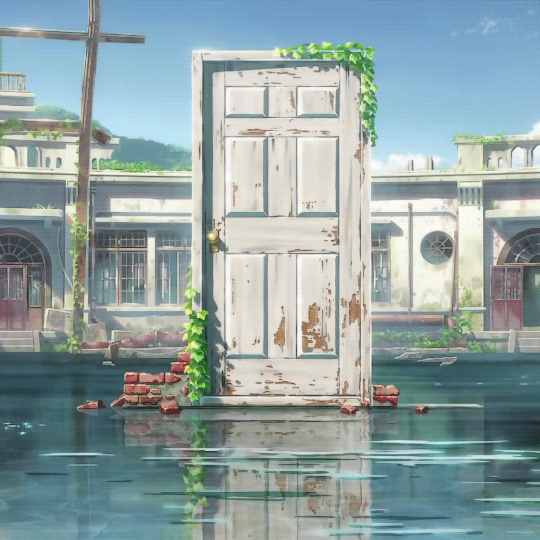
Anyway, this year Shinkai is back! His new film Suzume no Tojimari (すずめの戸締まり) has been getting strong praise from people who have seen it (e.g. my writing-about-animation senpai Matteo Watzky, usually a Shinkai skeptic). But… right now that pool is limited to people in Japan who can watch a film in the cinema, so we’ll have to keep that door shut for now. (I’m not sorry.)
Shinkai is a director who really led the charge in adopting new digital compositing tools in anime, and that has been a big focus of basically all his films - lushly rendered water drops, shots with the sun providing a lens flare to divide two characters, warm light spilling everywhere, lavish depictions of food to rival those at Ghibli, shiny surfaces with carefully depicted reflections. The effect draws a lot on photography, e.g. by simulating bokeh, but makes it heightened and hyperreal. By the time he made films like The Garden of Words (言の葉の庭, 2013), he had it down to a science. He’s inspired many imitators (not always successful), and it’s become a big part of the ‘anime look’ in the 2010s and 2020s.
A huge amount of credit must go to the background painters - their exceptionally detailed but still painterly look is a massive element in the Shinkai visual mix. One such artist on Shinkai’s later films is Mateusz Urbanowicz, a Polish-born watercolour painter and animator who apparently created 120 backgrounds for Your Name alongside various other anime films - you can find his Youtube channel here with a lot of watercolour paintings.
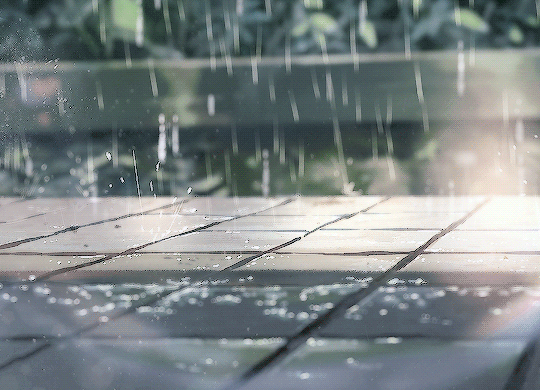
For an example of what I’m talking about, look at this shot from The Garden of Words. This shot is designed to create the appearance of a narrow focal range pointing at rain that is catching a beam of sunlight. Most of the background is blurred out using a lens blur filter. There are two layers depicting the actual raindrops. The further one (A layer) is just a bunch of streaks, which cycle through without much pattern; these are blurred out with the same bokeh filter.
On top of that (B layer), we have narrow, long streaks in the foreground depicting individual raindrops striking the tiles. These each appear on screen for only one drawing, and each one is associated with a bunch of particles; it is impossible to try and track individual splashes. There’s also a small amount of blurry mist. What really makes the effect though is the shadows of the raindrops where they hit the tiles, which really gives a convincing sense that the rain has depth in 3D space.
In the slightly nearer foreground, we have a shadow - creating a dark-light-dark value structure - and a bunch of little specular highlights of splashed drops which have also been lens blurred. To finish it off, there’s a blurry lens flare effect at the edge of the frame in the nearest foreground, with flickering pentagonal bokeh shapes. There’s even a layer of dust and scratches which flickers in and out as the reflected light catches it.
To create something like this takes an absurdly close study of real photographic footage. Why not just use that footage? By abstracting a little, making it constructed and removing distracting details, we turn it from just ‘a mechanical picture of rain’ to ‘what a person sees in rain’.
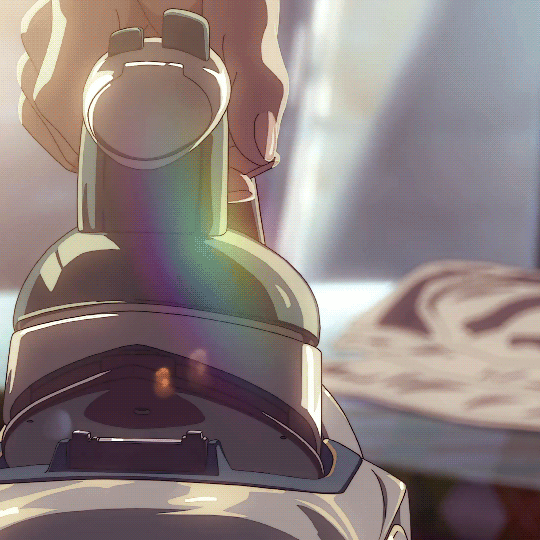
When this style works, it really works; when it doesn’t it, can be overbearing, or you can end up with a movie where the narrative gets a little lost. Last time I briefly compared Shinkai to his contemporary Naoko Yamada, who also draws heavily on photography and carefully observed naturalistic acting in her style. Shinkai himself once said he felt Yamada was the better director, and honestly, he’s right lmao - Yamada, in her work at both KyoAni and Science Saru (c.f. AN91 Heike Monogatari) has an unrivalled ability to turning these methods towards painfully nuanced depictions of character and emotion. But hey, there’s two cakes! Even if Shinkai’s films are ‘just’ a vehicle for spectacle - and honestly, at his best, that’s very much selling them short - what spectacle it is…
So, let’s pick up where we left off almost two years ago! We’ll sample a few more films from the last two decades of Shinkai and get more of a sense of how he developed his ‘thing’.
First up, we have the above mentioned Garden of Words (2013). This is the grounded end of the Shinkai range: an ephemeral relationship between two people who meet in a park without anything especially science fiction. It draws on a number of strands: Tokyo and its Shinjuku Gyoen National Garden, an old Japanese word for romantic love 孤悲 koi which glosses as “lonely sadness”, and a renowned collection of ten thousand poems from the late 700s called the Man’yōshū.
It tells the story of Takao, a lonely 15-year-old boy with an interest in shoemaking, who encounters an older woman in the above-mentioned park during the rainy season - a woman who unexpectedly recites an unfamiliar poem to him asking if he would stay if it rains. Gradually, it turns out that this is literature teacher Yukari Yukino, who has been mistreated at work and retreated to the park. Yukari gradually recovers from her despair, while Takao falls for her, but inevitably… well, this is Shinkai film. They’re not getting together. (Which is really for the best, considering she’s nearly twice his age.)
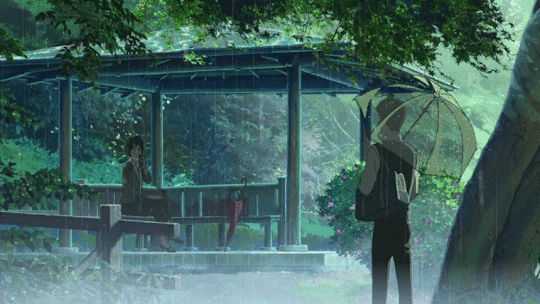
In accordance with its poetic inspiration, nature may be the main character of The Garden of Words. The relationship between the pair is framed through a pair of poems in the Man’yōshū, which you may read on Wikipedia along with a really thorough account of Shinkai’s inspirations and the movies themes. For my part, I’m going to have to leave it there - not least because it’s been a lot of years since I saw it, so I’d rather talk about it after a rewatch, not before.
Since I talked about backgrounds and compositing above, I should mention - this film makes especially heavy use of photography, with Shinkai (himself, I think?) directly painting over photos in photoshop in a lot of cases. Also notable is the digital integration of the cel-drawn characters into the ambient colour palette of the scene - something that is perhaps more standard now, but was novel at the time.
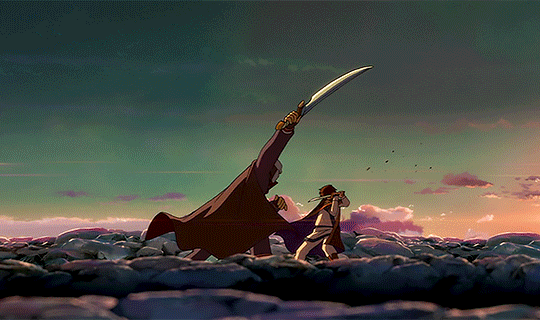
To complement that, our second Shinkai film of the evening will be Children Who Chase Lost Voices (星を追う子ども, 2011). This is at the other end of the Shinkai range: a grand scifi adventure into another strange world. It follows 6th-grader Asuna on a journey into the land of the dead to say goodbye to her classmate Shun, who died suddenly and unexpectedly. She’s joined by a number of other humans. The setting is a blend of esoteric ideas and mythology: Agartha, the world inside the hollow earth, is interpreted as an afterlife, and Aztec deity Quetzlcoatl as a psychopomp. Asuna and her companions must make their way through the world of Agartha, and Asuna must figure out what really motivates her.
This is a film in the same vein as something like Patema Inverted or Big Fish and Begonia - an imaginative but kind of thin fantasy setting, a relatable young protagonist with an emotional lesson to learn, a suitably misguided villain to complicate it. Like so many of Shinkai’s other films, it’s about a relationship that ends and the grief that carries, but this time, oh boy, it’s death! Which doesn’t mean it won’t be a solid, fun film.
I admit, I have less to say about this film - I have seen it, but so long ago that I remember only scant details. I think it will be an interesting one, not just as a fun summer movie type of story, but also historically since it represents a less refined Shinkai-the-compositor. Watching clips, the immediately striking thing is how just about every light source is given a flare - very noticeable when they flicker behind characters. Nevertheless, there’s a lot of nice things to see here. Even the beginnings of the fascination with drawing food…
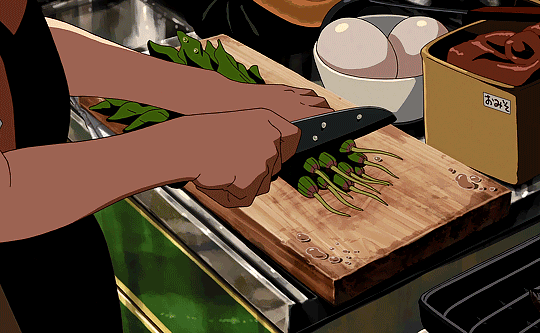
I’d love to tell you who animated this but it’s a case of artist_unknown! The fight scene further up is by Kenichi Tsuchiya though. If you look closely, you can see the camera spinning effect is defined by sliding static, painted ‘book’ layers, with Shinkai’s usual bokeh effects catching all the light highlights on the foreground rocks. Anyway, I’m sure I’ll have more to say about this movie when I’ve watched it.
What about Shinkai’s latest? I’ve been avoiding learning much about Suzume, since I’ve found lately it’s really good to go into a film knowing very little and just see where it takes you. If you’re out in Japan and get to go see it, I’m jelly, tell me what you think!
And that’s enough from me. Animation Night 132 will be live in just a moment, at the usual place, twitch.tv/canmom - films will be live in 30 minutes around 23:00 UK time. We’ll watch Voices and then Garden. Hope to see you there!
Comments